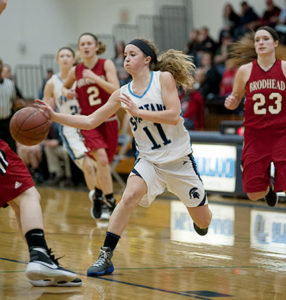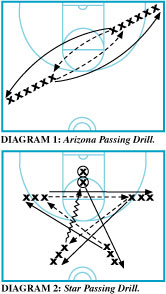Emphasizing passing, catching fundamentals reduces turnovers
One of the most under-taught skills in the game today is how to catch the basketball. To truly develop these skills, fundamentals need to be emphasized on a daily basis.
 Each time our team takes the floor for practice, we begin with a passing-and-catching drill. The first teaching point for receivers is to keep their eyes on the ball so they’re never surprised when a pass comes their way.
Each time our team takes the floor for practice, we begin with a passing-and-catching drill. The first teaching point for receivers is to keep their eyes on the ball so they’re never surprised when a pass comes their way.
‘See-the-ball’ technique
You’ll often hear coaches instructing players to “see the ball” on the defensive end of the court, but it’s just as critical on the offensive end. The technique is taken for granted in many drills, in which players already know which player is delivering them the ball and at what time.When a player cuts to a designated spot on the court or is moving toward that position, the place on the floor where he or she wants to receive the ball that player should indicate readiness to receive a pass by showing a hand target to the passer. If this spot on the floor is one in which the player is able to catch and shoot, his or her hands should be positioned so that the palm of the shooting hand is showing to the passer and the opposite hand is in position to catch and guide the shot on the side of the ball.
These “hand targets” also should be made with both arms outstretched to shorten the pass as much as possible. Provide space for the hands to allow a little “give” so that the pass can be cushioned on the catch.
‘Meet-the-ball’ technique
As the ball is being passed, receivers should always move to meet the ball as opposed to waiting for the ball to reach them. Utilizing this technique, even when a bad pass is made, prevents many turnovers and deflections.
At the time when the receiver is about to meet the ball, he or she should square up to the ball while it’s in the air and continue to move toward it so that his or her chest is behind the ball. This jumping movement should be no higher than a properly executed jump-stop that skims the surface of the ground.
This technique gives the receiver extra security in the event of a bobbled or missed ball, allowing the body to block the ball and not let it get by him or her. This strategy is similar to that of a baseball player who is taught to get his or her body in front of a ground ball.
On every pass, the receiver should look the ball into his or her hands and make sure the hands are relaxed. The ball should make contact initially with a player’s finger pads and not the palm.
Triple-threat positioning
As the pass hits the receiver’s hands, he or she should allow for a little “give” by pulling the hands slightly back toward the body, almost as if catching a water balloon so that it doesn’t burst on contact. There should be plenty of room to allow for this “give” if his or her arms are outstretched as instructed.

As the player comes down from squaring to the ball while in the air, he or she should land with a jump-stop and in triple-threat position. Landing in this position lets the player go directly into a shot pass or dribble attack. Additionally, the jump-stop provides the receiver with the freedom to choose the pivot foot to utilize, giving them multiple options on a dribble attack by attacking the defender’s front foot.
Passing catching drills
At the beginning of the season, it’s appropriate to begin instruction on passing and catching by utilizing stationary partner-passing drills. Be sure to emphasize concentration and the proper fundamentals of the catch.
Over the course of the season, the team can move on to the Arizona passing drill that divides the team into two lines where players use one ball and follow their pass into the opposite line. The follow-your-pass technique can then be expanded into the star drill.
If coaches take the time to teach the proper fundamentals of catching the ball, and consistently emphasize sound passing and catching techniques during all drills, it results in an offense that produces better ball and player movement and will definitely reduce your team’s turnovers.









